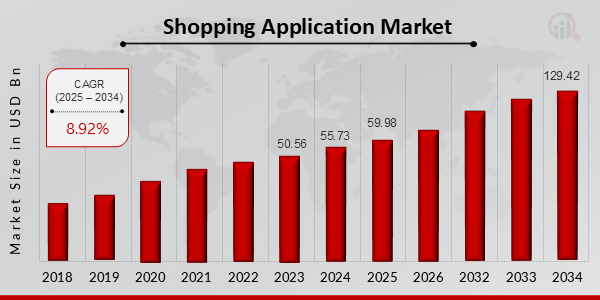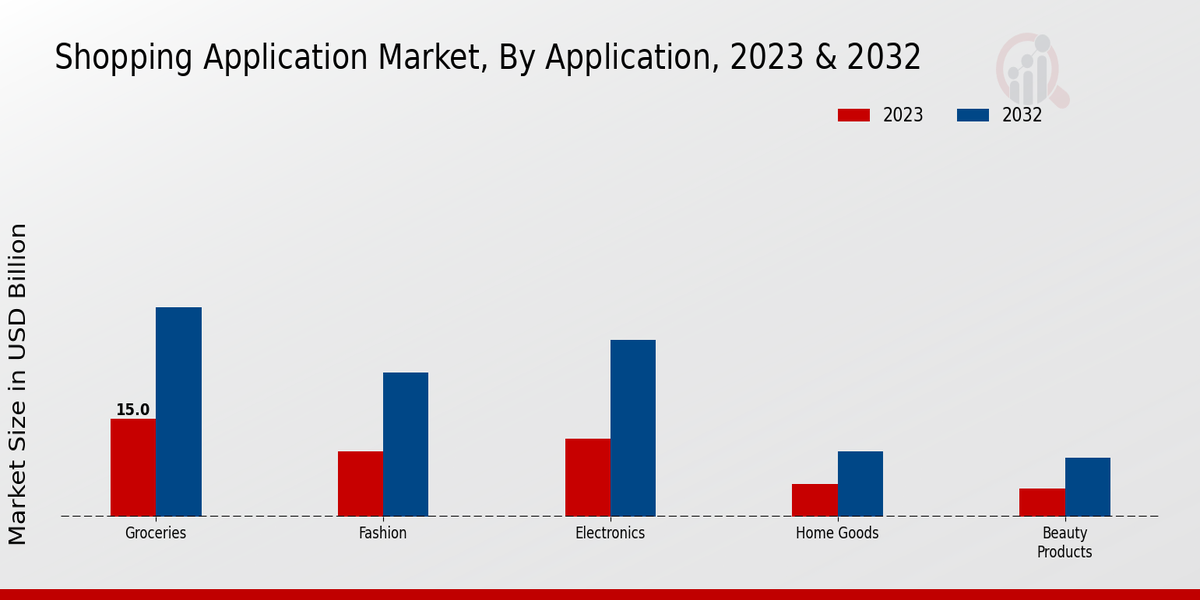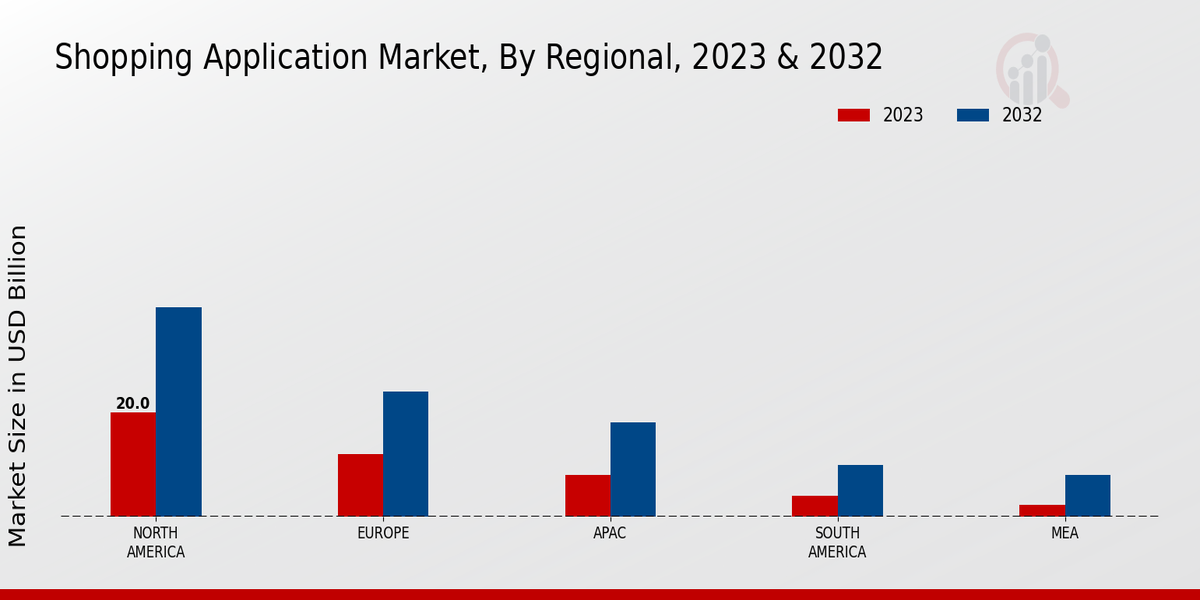Shopping Application Market Overview
Shopping Application Market is projected to grow from USD 59.98 Billion in 2025 to USD 129.42 Billion by 2034, exhibiting a compound annual growth rate (CAGR) of 8.92% during the forecast period (2025 - 2034). Additionally, the market size for Shopping Application Market was valued at USD 55.73 billion in 2024.
Key Shopping Application Market Trends Highlighted
The shopping application market is driven by the increasing adoption of smartphones and the growing internet penetration around the world. As consumers become more comfortable with digital transactions, the demand for convenient shopping solutions is rising. Additionally, the shift towards contactless shopping, accelerated by recent events, has further fueled the market. Retailers are integrating advanced technologies like artificial intelligence and augmented reality to enhance the shopping experience, making applications more appealing and efficient for consumers. Opportunities in the market remain robust, particularly for companies that focus on improving user experience and personalization.
As more people shop online, businesses can capture new customers by offering tailored products and recommendations. Expanding into emerging markets presents significant growth potential, as these regions have a rapidly increasing number of internet users. There is also a great opportunity to integrate social commerce features that allow users to shop directly through social media platforms, leveraging the influence of social connections and trends. Recent trends indicate a growing preference for omnichannel shopping experiences, where consumers expect seamless integration between online and offline stores.
Many shopping applications are now incorporating features that allow easy transitions between mobile devices, websites, and physical stores. Sustainability is also becoming important, with consumers increasingly looking for eco-friendly products and practices. The fusion of shopping applications with lifestyle services, such as delivery and customer support, is enhancing customer loyalty and engagement. This changing landscape creates a dynamic environment for innovators and established players to continually evolve their offerings and strategies.
Figure 1: Shopping Application Market Size, 2025-2034 (USD Billion)

Source: Primary Research, Secondary Research, Market Research Future Database and Analyst Review
Shopping Application Market Drivers
Increasing Smartphone Penetration
The rapid increase in smartphone penetration globally is a significant driver of growth in the Shopping Application Market Industry. With millions of consumers accessing the internet through their mobile devices, shopping applications have become an essential tool for buyers seeking convenience and accessibility. Phones equipped with advanced features and high-speed internet connectivity facilitate seamless shopping experiences. This has led consumers to prefer online shopping over traditional brick-and-mortar stores, especially as shopping applications become more user-friendly and offer numerous functionalities.
Features like personalized recommendations, easy payment methods, and the ability to track orders in real time contribute to the appeal of shopping applications. As smartphones evolve with better performance and enhanced user interfaces, they continue to engage consumers, expanding the Shopping Application Market Industry further. The growing tendency for individuals to make purchases on their mobile devices indicates a shift in consumer behavior, with shopping applications becoming the preferred means of purchasing goods and services.
Hence, as smartphone usage continues to surge, the Shopping Application Market is likely to experience substantial growth, offering innovative features and improving services to meet the demands of a tech-savvy consumer base.
Rising E-Commerce Adoption
The rising adoption of e-commerce is a pivotal driver of the Shopping Application Market Industry. As more consumers embrace the idea of Internet shopping for convenience and variety, shopping applications are becoming integral to the e-commerce ecosystem. The pandemic has accelerated this trend as people sought alternative ways to shop while adhering to safety protocols. Retailers are recognizing this shift and increasingly investing in their online presence to capture a larger market share, which bolsters the growth of shopping applications.
Enhanced logistics and delivery services are also facilitating e-commerce, making shopping apps indispensable for modern consumers.
Preference for Contactless Shopping
The growing preference for contactless shopping experiences is significantly impacting the Shopping Application Market Industry. Consumers are increasingly prioritizing safety and convenience during their shopping journeys, particularly in the wake of recent health concerns. Shopping applications that offer contactless payment options and deliver items directly to doorsteps are gaining popularity. This shift not only meets consumer demand for safety but also streamlines the purchase process, making it quicker and easier to complete transactions.
Personalization and AI Integration
The integration of advanced technologies, such as artificial intelligence, is driving growth in the Shopping Application Market Industry. Personalized shopping experiences enhance customer satisfaction by providing tailored recommendations based on individual preferences and shopping behavior. This trend is becoming increasingly important as consumers expect shopping applications to understand their needs and present relevant products. AI algorithms can analyze vast datasets to identify trends and consumer preferences, resulting in more effective marketing strategies and improved customer engagement.
Expansion of Digital Payment Solutions
The expansion of digital payment solutions is a crucial driver for the Shopping Application Market Industry. As consumers seek secure and efficient ways to complete transactions, the adoption of diverse payment methods, including mobile wallets and cryptocurrencies, is on the rise. Shopping applications that support multiple payment options cater to a broader audience, enhancing user trust and satisfaction. This flexible approach to payments not only improves the shopping experience but also encourages repeat purchases, which is vital for long-term growth.
Shopping Application Market Segment Insights
Shopping Application Market Application Insights
The Shopping Application Market is experiencing robust growth, reflecting a shift in consumer behavior towards online shopping. By 2023, the overall market is valued at 46.41 USD Billion, with projections pointing towards a significant increase to 100.0 USD Billion by 2032. Within this market, the application segment is intricately divided into various categories, including Groceries, Fashion, Electronics, Home Goods, and Beauty Products, each contributing uniquely to the market revenue.
The Groceries category stands out with a valuation of 15.0 USD Billion in 2023 and is set to rise to 32.0 USD Billion by 2032, indicating strong consumer demand for online grocery shopping driven by convenience and time-saving needs.
Fashion is another prominent segment, projected to grow from 10.0 USD Billion in 2023 to 22.0 USD Billion in 2032, demonstrating a significant interest in e-commerce platforms for clothing and accessories as consumers increasingly seek variety and accessibility. The Electronics segment, valued at 12.0 USD Billion in 2023 and expected to reach 27.0 USD Billion by 2032, illustrates a growing trend towards purchasing tech gadgets online, likely influenced by the rapid advancements in technology and a rise in remote work culture.
Home Goods, though relatively smaller, show a steady valuation from 5.0 USD Billion in 2023 to 10.0 USD Billion in 2032, reflecting an opportunity for growth as more consumers invest in home improvement and décor through online applications. Lastly, the Beauty Products category, starting at 4.41 USD Billion in 2023 and increasing to 9.0 USD Billion by 2032, highlights the significant shift towards digital beauty solutions and the influence of social media on purchasing choices.
Collectively, the market statistics reveal a well-rounded structure within the Application segment, with each category playing a pivotal role in driving market growth, showcasing an accelerated transition towards digital shopping experiences that cater to a broad range of consumer needs and preferences.

Source: Primary Research, Secondary Research, Market Research Future Database and Analyst Review
Shopping Application Market Device Type Insights
The Shopping Application Market is an expanding sector in the digital commerce landscape, marked by significant growth attributed to varying Device Types. In 2023, the overall market was valued at 46.41 USD billion, reflecting the increasing consumer reliance on technology for shopping experiences. Within this market, smartphones remain a dominant force due to their accessibility, facilitating on-the-go shopping and enhancing user engagement. Tablets also contribute notably, providing a larger screen experience that appeals to family-oriented purchases. Meanwhile, desktops and laptops continue to serve as important platforms for online shopping, particularly for consumers seeking detailed product information and high-value purchases.
The Shopping Application Market revenue is buoyed by trends like mobile optimization and enhanced user interfaces, while data privacy and security concerns challenge continuous growth. Opportunities lie in the integration of artificial intelligence and augmented reality to improve user experiences across all device types, underscoring the dynamic nature of this evolving industry. Understanding the Shopping Application Market segmentation based on Device Types helps stakeholders identify key growth drivers and tailor strategies to meet changing consumer demands effectively.
Shopping Application Market Business Model Insights
The Shopping Application Market is expected to reach a valuation of 46.41 USD Billion in 2023, reflecting its robust growth trajectory driven by various business models. Among these, the B2C model holds a significant position, primarily due to the increasing preference for online shopping among consumers, making it essential for retailers to create user-friendly platforms that enhance the shopping experience. The C2C model is also gaining traction, as it enables consumers to trade directly with one another, facilitated by digital marketplaces that promote peer-to-peer transactions.
Meanwhile, the B2B model is crucial for wholesale transactions, connecting manufacturers with retailers, and driving efficiency in supply chains. Lastly, the C2B segment has emerged, allowing consumers to sell products or services to businesses, creating opportunities for both parties in niche markets. The overall Shopping Application Market data indicates a consistent market growth influenced by evolving consumer behaviors, technological advancements, and the shifting dynamics of retail. As a result, the Shopping Application Market industry is witnessing a dynamic evolution across these business models, with each contributing to an expansive market growth potential.
Shopping Application Market Payment Method Insights
The Payment Method segment of the Shopping Application Market has gained significant traction and is poised for growth, driven by a robust overall market valued at 46.41 (USD Billion) in 2023. This segment is characterized by a range of payment options that cater to diverse consumer preferences. Credit and debit cards are widely used due to their established trust and ease of use, making them a preferred method for many online shoppers. Digital wallets have emerged as a formidable player in the market, appealing particularly to tech-savvy consumers seeking quick and convenient transactions.
Net banking continues to hold relevance, especially for consumers who prioritize security and direct account transactions. Additionally, Cash on Delivery remains vital in regions where credit facilities are less accessible, bridging the gap between traditional and modern payment paradigms. These payment methods not only enhance user experience but also influence the Shopping Application Market revenue through higher transaction volumes and increased customer loyalty, reflecting the dynamic and evolving nature of consumer payment preferences in a digital age.
As the market continues to expand, these payment methods will play a critical role in shaping the future of online shopping experiences, with the overall market expected to reach 100.0 (USD Billion) by 2032, showcasing steady market growth and increasing financial inclusivity.
Shopping Application Market Regional Insights
The Shopping Application Market is experiencing robust growth, with Regional segmentation revealing significant insights. In 2023, North America dominates the market with a valuation of 20.0 USD Billion, projected to reach 40.0 USD Billion by 2032, showcasing its majority holding in the overall landscape. Europe follows with a value of 12.0 USD Billion in 2023, expected to double to 24.0 USD Billion by 2032, highlighting its significant role in the industry. The APAC region, valued at 8.0 USD Billion in 2023, is set to expand to 18.0 USD Billion, indicating growing consumer adoption of e-commerce.
South America, although smaller, with a current valuation of 4.0 USD Billion, is projected to rise to 10.0 USD Billion, indicating emerging opportunities in this market. Meanwhile, the MEA region, valued at 2.41 USD Billion in 2023, showcases potential with an expected growth to 8.0 USD Billion. The diverse market growth across these regions is driven by increased mobile penetration, changing consumer preferences, and technological advancements, making the Shopping Application Market a focal point for investments and innovations.

Source: Primary Research, Secondary Research, Market Research Future Database and Analyst Review
Shopping Application Market Key Players and Competitive Insights
The Shopping Application Market has experienced significant growth and transformation in recent years, driven by advancements in technology, shifting consumer preferences, and an emphasis on convenience and accessibility. As more people turn to mobile devices for their shopping needs, numerous companies are vying for market share by enhancing their applications, improving user experiences, and expanding their product offerings. The competitive landscape is characterized by a mix of established retail giants and emerging startups, each striving to capture the attention of increasingly discerning consumers.
Key factors contributing to the competitive dynamics include features such as personalized shopping experiences, seamless payment methods, and effective customer engagement strategies. As competition intensifies, businesses are focusing on innovation and differentiation to carve out their niche within the market.
JD.com has managed to establish a robust presence in the Shopping Application Market through its commitment to customer satisfaction and operational efficiency. The company's strength lies in its comprehensive logistics network, which allows for faster delivery times and a streamlined shopping experience. By leveraging advanced technology such as artificial intelligence and data analytics, JD.com enhances its recommendation algorithms, ensuring personalized experiences that resonate well with users. The company's focus on quality control and authentic products further strengthens its reputation among consumers, making it a go-to platform for online shopping.
Additionally, JD.com's initiative to collaborate with various brands and retailers to provide exclusive offerings and competitive pricing has solidified its position as a leader in the market.
eBay, as a pioneer in the online marketplace realm, has carved out a unique space within the Shopping Application Market by facilitating consumer-to-consumer sales and auctions. Its strength lies in the diverse range of products available, catering to various consumer needs, from vintage items to brand-new products. eBay's platform encourages sellers to list their goods competitively, creating an extensive assortment for buyers and fostering a dynamic marketplace environment.
The company's user-friendly interface and community-driven features enhance customer engagement, while its reach allows users from different regions to connect and transact seamlessly. Additionally, eBay’s initiatives in improving mobile commerce capabilities and investing in marketing strategies have helped sustain its relevance and appeal amidst growing competition from newer players in the market, thus maintaining a strong foothold in online shopping.
Key Companies in the Shopping Application Market Include:
Shopping Application Market Industry Developments
Recent developments in the Shopping Application Market have been marked by significant partnerships and technological advancements among key players. JD.com has expanded its reach through collaborations aimed at enhancing its logistics and delivery capabilities, effectively improving customer experience. eBay continues to innovate by introducing new features for sellers to enhance their engagement on the platform. Best Buy is investing in augmented reality technology to provide customers with a more immersive shopping experience.
In the international arena, Rakuten has made strides in expanding its marketplace features to attract more merchants. Zalando has been focusing on sustainability by integrating eco-friendly practices into its operations. Meanwhile, Flipkart's valuation has surged due to increased online shopping demand, further bolstered by investments from Walmart. Mercado Libre is also seeing substantial growth in its Latin American operations.
Additionally, Target is leveraging data analytics to refine its inventory management, improving efficiency. Amazon and Shopify are at the forefront of e-commerce innovation, continuously upgrading their platforms to enhance user experience and payment solutions. Overall, the competitive landscape is characterized by strategic moves that are reshaping consumer shopping experiences in the digital realm.
Shopping Application Market Segmentation Insights
-
Shopping Application Market Application Outlook
-
Groceries
-
Shopping Application Market Device Type Outlook
-
Smartphones
-
Shopping Application Market Business Model Outlook
-
B2C
-
Shopping Application Market Payment Method Outlook
-
Credit/Debit Cards
-
Shopping Application Market Regional Outlook
-
North America
| Report Attribute/Metric |
Details |
|
Market Size 2024
|
55.73 (USD Billion)
|
|
Market Size 2025
|
59.98 (USD Billion)
|
|
Market Size 2034
|
129.42 (USD Billion)
|
|
Compound Annual Growth Rate (CAGR)
|
8.92% (2025 - 2034)
|
|
Report Coverage
|
Revenue Forecast, Competitive Landscape, Growth Factors, and Trends
|
|
Base Year
|
2024
|
|
Market Forecast Period
|
2025 - 2034
|
|
Historical Data
|
2019 - 2023
|
|
Market Forecast Units
|
USD Billion
|
| Key Companies Profiled |
JD.com, eBay, Best Buy, Rakuten, Zalando, Flipkart, Mercado Libre, Target, Alibaba, Tmall, Walmart, Sears, Etsy, Amazon, Shopify |
| Segments Covered |
Application, Device Type, Business Model, Payment Method, Regional |
| Key Market Opportunities |
Personalized shopping experiences, Augmented reality integration, Expansion into emerging markets, Sustainable and ethical shopping features, and Mobile payment innovations. |
| Key Market Dynamics |
Mobile commerce growth, User experience enhancement, Personalization and recommendations, Integration of AR/VR, Payment security advancements |
| Countries Covered |
North America, Europe, APAC, South America, MEA |
Frequently Asked Questions (FAQ):
The Shopping Application Market is expected to be valued at 129.42 USD Billion by the year 2034.
The expected CAGR for the Shopping Application Market from 2025 to 2034 is 8.92%.
North America is anticipated to have the largest market share, valued at 40.0 USD Billion by 2032.
The Grocery application segment is projected to be valued at 32.0 USD Billion by the year 2032.
Key players in the Shopping Application Market include Amazon, Alibaba, Walmart, and eBay, among others.
The Fashion application segment is expected to reach a market value of 22.0 USD Billion by 2032.
The Electronics segment is projected to be valued at 27.0 USD Billion by the year 2032.
The market for Home Goods is expected to grow to 10.0 USD Billion by 2032.
The Beauty Products application segment is projected to be valued at 9.0 USD Billion by the year 2032.
The APAC region is projected to experience significant growth, expanding from 8.0 USD Billion to 18.0 USD Billion by 2032.

















